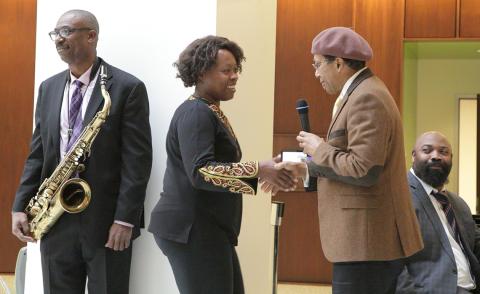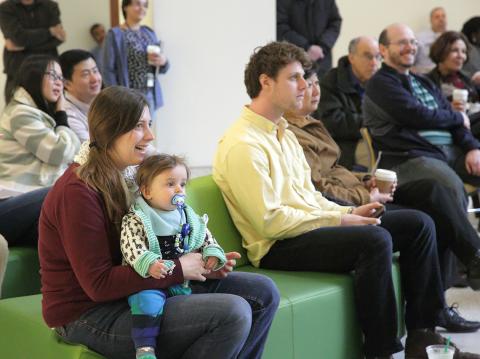‘Spiritual Music’ Celebrates Black History Month

Photo: Bill Branson
If the highly successful “afternoon of jazz” held Feb. 25 in the Porter Bldg. atrium in celebration of Black History Month is to honor its inaugural guest artist, it will have to go by another name in future years.
Drummer Nasar Abadey led a quartet through half a dozen standards—leaning on the work of D.C. native Duke Ellington—in a 90-minute concert punctuated by Abadey’s congenial dialogues about the music.
“This music represents good times,” he began, stepping out from behind his drum kit to discuss the first tune, Ellington’s Take the Coltrane.
“The blues is the foundation of jazz,” he explained, adding that the music merges two traditions, one European, the other African.

Photo: Bill Branson
“I don’t like to call it jazz,” Abadey said. That term has its origins in houses of ill repute, he noted. “This is a spiritual music. We consider it sacred.”
Abadey, 69, who began playing drums at age 5 and who has accompanied such giants as Dizzy Gillespie, Ella Fitzgerald, Sun Ra and Pharoah Sanders, said there are two kinds of standard tunes. “There are the Tin Pan Alley songs, mostly from Broadway musicals, but with a jazz treatment, like Body and Soul. And then there are jazz standards, written by jazz musicians.”
The second tune was Ellington’s ballad In a Sentimental Mood.
The third offering, Sonny Rollins’ St. Thomas, is really just a variation on Ellington’s I’ve Got Rhythm, said Abadey. He invited the audience to “step outside yourselves. We’re playing a song that’s danceable…Do you all know each other? Now is the time to let each other know what you’re all about!”
The Rollins song is known as a calypso, “pronounced kye-yip-so,” said Abadey. “It’s based on a west African rhythm called fanga. So fasten up! Got life insurance?”

Photo: Bill Branson
Once the tune ended, he presented a free copy of his band’s latest CD to a woman in the audience who had the courage to dance.
“These musicians—they are so professional, they play so well—we are not rehearsed at all,” said Abadey, who turned out to be a charismatic music educator. “We’re not reading music. We are playing this music from our hearts…Jazz musicians get to the point where you know the songs so well, you play them. We’re improvising. We’re just feeling it from within.”
His bandmates included pianist Allyn Johnson, who directs the jazz studies program at the University of the District of Columbia, bassist James King, Jr., a touring musician just back from a West Coast swing, and tenor saxophonist Paul Carr, executive director and artistic director of the recently concluded Mid-Atlantic Jazz Festival, held each year just up the Pike in Rockville.

Photo: Bill Branson
Defining rock ’n roll as another element of the blues, Abadey and his band launched into Herbie Hancock’s Cantaloupe Island, which shares rock’s more percussive elements. “Any more dancers in the house?” Abadey shouted.
There was a bit of confusion about whether the show was supposed to last an hour, or 90 minutes. Abadey solved the problem by announcing I Don’t Know, an improvisational workout.
“We’re gonna see what happens,” he said. “We’re gonna stack it. We’re going to totally improvise until someone in the band states a melody, then we’ll all dive in. It’ll be free for awhile, then it will go into something and you’ll recognize the song.” As with his other scholarly questions, the correct answer earned respondents a free CD.

Photo: Bill Branson
It turned out that no one recognized the standard All the Things You Are.
The band finished with an uptempo blues, bassist Buster Williams’ Tokudo.
Abadey and his band, impressed that the NIH audience offered serious attention, declared the gig a success. “We would really like to be back to see you again.”
The performance was sponsored by the Porter Neuroscience Research Center arts committee and Dr. Larry Samelson, chair of the FAES music committee.
